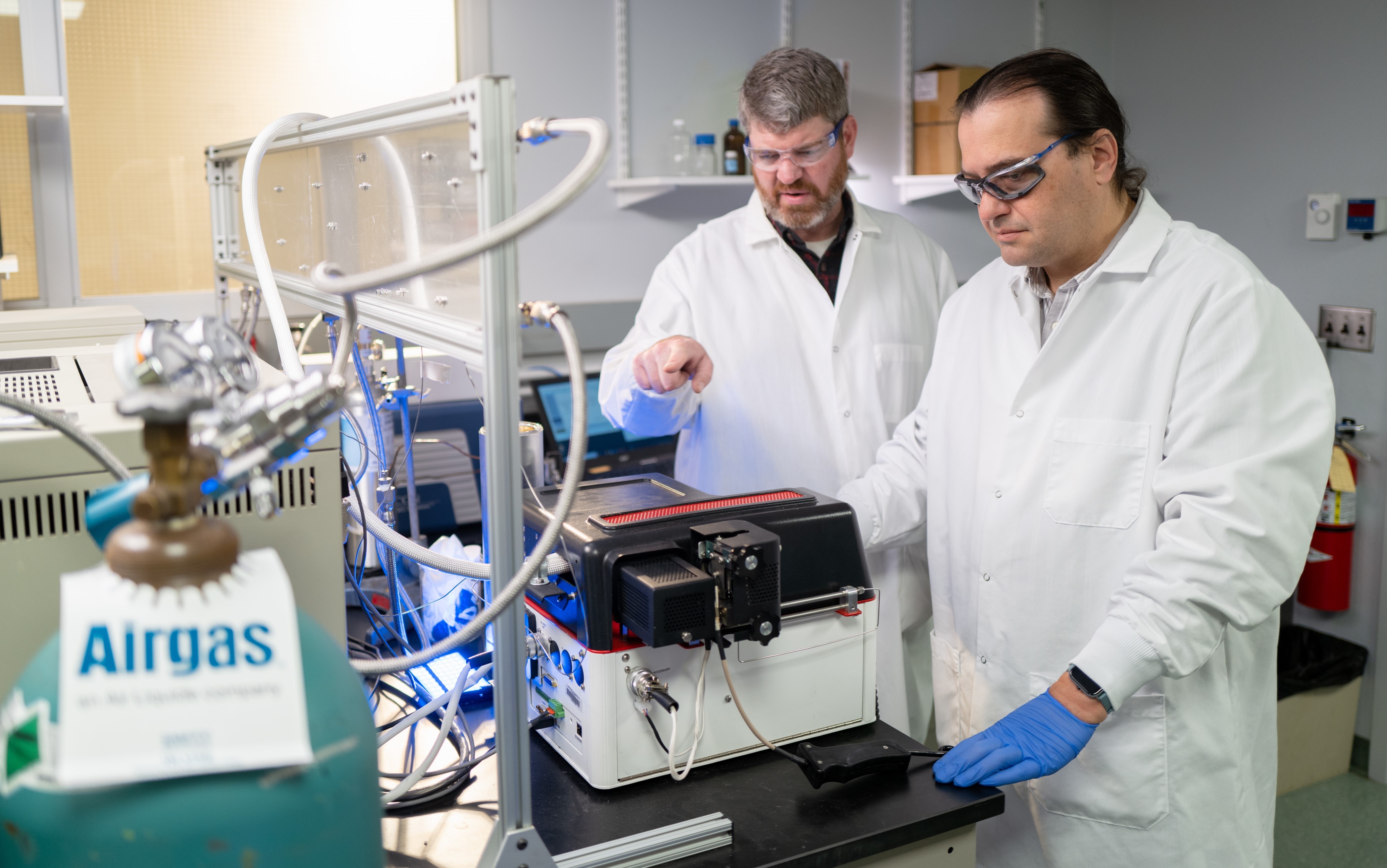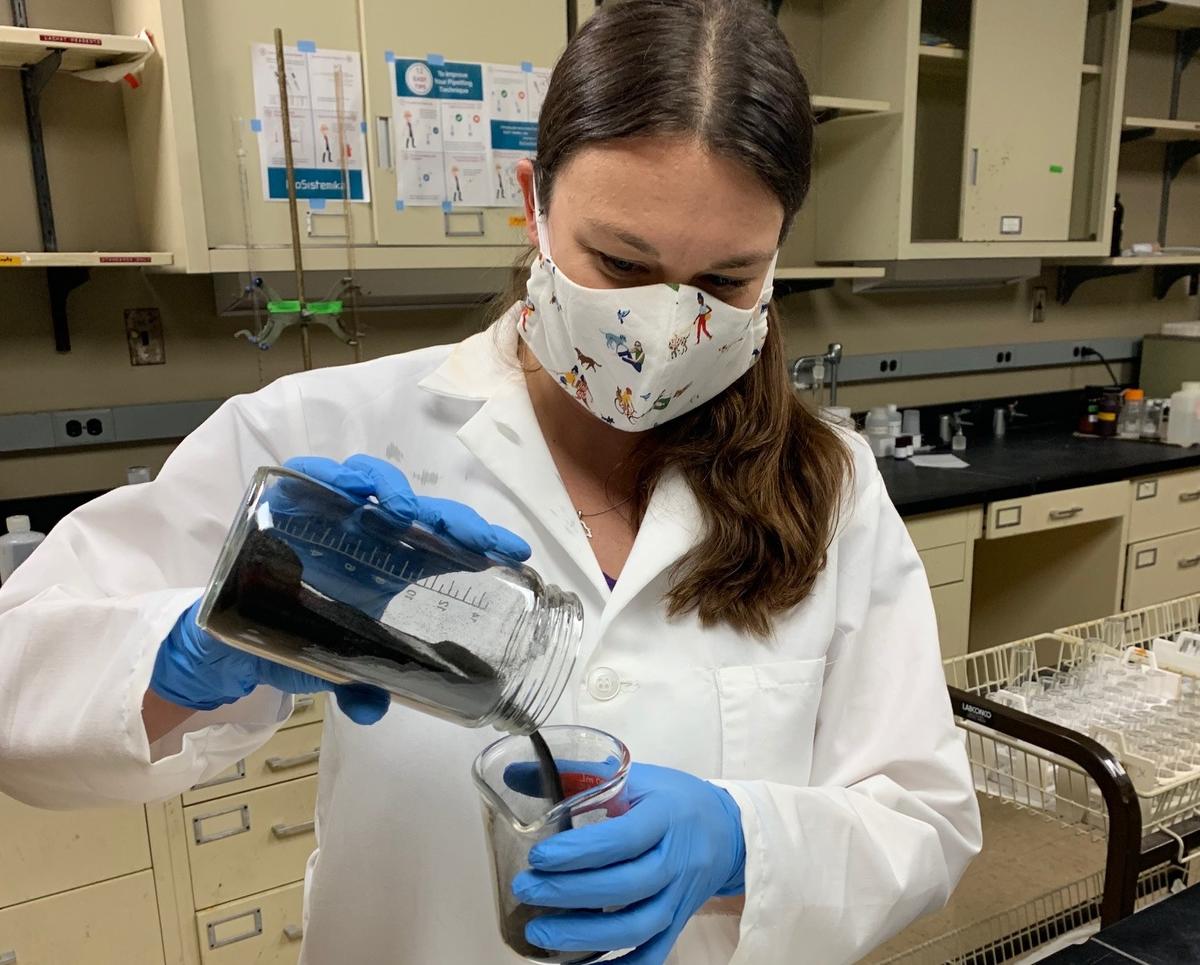Back in 2008, scientists started calling biochar “black gold” for its ability to improve poor agricultural soils. But in this era of climate change concern, biochar’s bigger value may be as a significant carbon sink opportunity. It has earned a respected place in the $1 billion carbon offset credit market, offering companies a way to mitigate their carbon impact by removing carbon elsewhere.
Meanwhile, this “black gold” can do another important job – filtering contaminants from stormwater runoff. But not all biochars are created equal. And the function depends on both the type of contaminant and the type of biochar.
A team of NRRI researchers are working to sort it all out. Environmental Chemist Bridget Ulrich leads one team in collaboration with the Chemistry and Materials Science team. Together, they have made significant headway in understanding what it takes to use biochar effectively to filter stormwater pollutants, conducting a series of experiments from lab scale to demonstration scale.
And what they’ve learned is…. it’s complicated.
“Biochar is not the silver bullet; it has limitations and challenges,” said Ulrich. “But it can be very useful if used correctly.”
Understanding Biochar
Biochar is (not so simply) charred biomass, like charcoal but with key differences. The beauty of biochar is in its pores, especially biochars with micropores – tiny channels within the biochar material – called “intraparticle” porosity.

These micropores can provide some biochars with up to 5,000 square feet of surface area per gram. But not all biochars contain surface areas of this magnitude. Biochars with low porosity can house surface areas of less than a hundred square feet per gram. To the naked eye, most biochars appear the same, a black powdery substance. But at the microscale, it’s like the difference between a mansion and a shed.
Biochar is commonly produced by pyrolysis, heating in a low-oxygen kiln, in ranges of 500 degrees F to nearly 2,000 degrees F (250 Celsius to 1,000 Celsius). In contrast to combustion, which converts carbon in biomass to carbon dioxide, pyrolysis instead concentrates the carbon to a form that can remain stable for hundreds of years. This is what makes biochar a potential “carbon sink.”
Kiln temperatures and different biomass feedstocks – from wood waste to agricultural waste – affect the properties of the end biochar product. For example, biochars produced from woody feedstocks at higher temperatures tend to contain higher porosities and higher fixed carbon content. In contrast, biochars produced from the same feedstock but at lower temperatures have lower microporosities and less charred surfaces. The variety of equipment being used also changes the outcomes.
Biochar applied as an agricultural soil amendment or to capture carbon is largely dependent on the amount of stable carbon in the final product. But capturing finicky contaminants requires a variety of process considerations to ensure the selected biochar has the right properties for the job.
“There are a lot of studies out there about how the contaminants are removed with biochar at the lab scale,” said Ulrich. “But that knowledge isn’t being translated consistently into the biochar production industry. Our work to fill in the gap at intermediate scales will help with that translation.”
In the Lab

Ulrich’s team is testing and documenting which contaminants are best filtered with which biochars. They are also working with the Chemistry and Materials team to understand what material properties make biochars effective for filtering contaminants. Ultimately, NRRI researchers hope to be able to provide a biochar guide with specifications for the type of biochar needed to remove specific contaminants.
They’ve identified key properties including the intraparticle porosity – the space available to house contaminants – surface chemistry. And while “the bigger the better” may be true for contaminants that are drawn to higher fixed carbon surfaces (such as organic contaminants like pesticides), this is not necessarily true for all contaminants. For example, contaminants like dissolved metals, which are positively charged, tend to be more attracted to less charred surfaces, which contain more negatively charged sites.
“It’s important for stormwater treatment facilities to first know what their primary target is for contaminant removal,” Ulrich explained. “Then they can acquire a biochar that has the properties with the best chance for success and test it to make sure it works under environmentally relevant conditions.”
Real World Trials
Ulrich’s team is working with several partners to help translate success from the laboratory to the field. Over the last two years, they have been working with the Mississippi Watershed Management Organization to install biochar in a demonstration-scale stormwater filtration system. This mobile unit will evaluate its effectiveness for treating parking lot runoff before it drains into the Mississippi River.
They also recently partnered with the Lake County Soil and Water Conservation District to assess the performance of a new biochar filter. It will be installed this summer to treat runoff draining into Agate Bay.
Addressing Challenges
One of the challenges is understanding how biochar performance differs in the lab where conditions are clean and controlled, versus in the environment where conditions can be dirty and unpredictable. The researchers are addressing this problem by conducting experiments that simulate realistic conditions and using natural waters, but in filter vessels that can fit in a greenhouse.
And there are more challenges. Biochars that are produced under controlled conditions in the lab are not available at scales large enough to install in treatment systems in the field. Most biochar products on the market today are meant for soil amendment, and their potential effectiveness for stormwater treatment is unclear.
NRRI is working to span this scale-up gap between bench and demonstration scale production. A mid-sized kiln will be acquired allowing them to produce kilogram quantities of custom, experimental biochar at a time. The researchers will evaluate the performance of the biochar materials under realistic conditions to influence production procedures adopted by large scale producers.
“I think, as we work more on these intermediate scales to evaluate performance there might be more of a market ahead for biochars specialized for water treatment,” Ulrich said. “I see a niche emerging for biochars produced under more controlled processes.
“If it’s certified for specific uses, it could be a value-add material. But we need to make sure we don’t over engineer ourselves out of the market,” she added.
